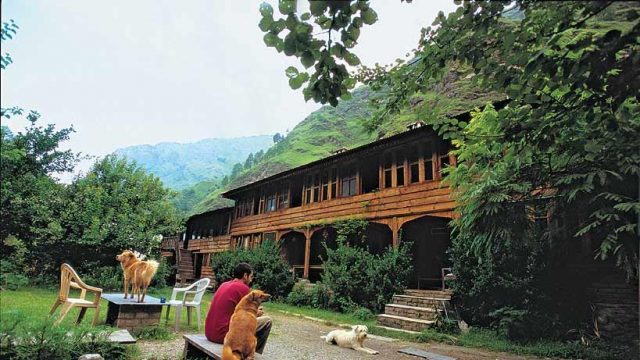Leaving Delhi on a Friday morning, we cleared Kashmiri Gate by 7 am. There was little respite from the sultry Gangetic weather until we passed through Mandi later that evening, when we were treated to a downpour. Forty kilometres on, we stopped at a roadside town called Aut, from where we were supposed to phone our weekend host, “Mr Raju”. To get to Gushaini, Raju explained, we needed to turn off the main highway and take a confusing set of rights and lefts. “It’s best to keep asking people along the way,” he said. “And when you get to a parking area with some jeeps, honk. I’ll come out and help you across the bridge.”
Darkness had fallen by the time we pulled up to the banks of the Tirthan River and honked our horn as instructed. Within moments, a gaunt man was making his way towards us with a torch. “Hello, I’m Raju,” he called out, his toothy smile both awry and affable.
Following our host along a stony path that skirted the river’s edge, we finally gazed upon the notorious bridge. A one-inch-thick wire hung across the roaring Tirthan, and a metal basket hung from it on two pulleys. “You people can cross the river on that thing,” our driver muttered, “I’m going to sleep in the car.” After a day of his erratic driving on hairpin curves, a vengeful side of me was gratified by his fear.
I cautiously stepped into the basket, and Raju pushed me out over the rapids. Midway across the bridge, Himalayan snowmelts surging beneath me, I inhaled the surrounding wilderness and smiled euphorically. This was going to be no ordinary weekend in the hills.
On the other side of the river, the three immaculate and warm guestrooms that occupy the first floor of Raju’s home are filled with custom-made wood furniture and multiple beds. Hand-woven throws cover the beds and hand-made mobiles are draped from lights and ceilings. The bathrooms are modern but maintain a rustic feel with slate floors and wooden cabinets. Raju prides himself on his use of local raw materials.
Next came dinner, which was served in a cosy dining area. On our first night, we ate Indian, the chef’s deft hands reinventing simple dishes like daalmakhni, karhichawal and rajma. She also does Chinese and Continental, cleaner and simpler than any urban attempts.
Raju joined us as we devoured our dessert, custard filled with fruit grown on his twenty-two-acre estate — grapes, apples, apricots, plums. While orchards provide him with the bulk of his income, running his guesthouse is more a hobby. “It allows me to meet different people,” he says. Rather than ending up loud and sprawling like Manali, Raju would like to see tourism in the surrounding valley develop using the homestay concept as a sustainable model.
Guests have been visiting Raju’s Guesthouse in Gushaini since 1995, initially enticed by the angling. Besides the fish in the river, black bears, barking deer and monkeys are spotted on the property from time to time. When his dog Bhalu was just a puppy, Raju explained, while fawning over the sagacious red animal, he had a close encounter with a leopard that was prowling around the orchards. Still, the valley’s symphony — river and crickets—coaxed me into the deepest slumber I’d had in weeks.
We started off our first morning sipping tea on the veranda outside our rooms. The veranda looks upon a perennial garden, behind which loomed the verdant summer hills of the lower Himalaya dotted with hundreds of ripe apple trees.
After breakfast and a jeep ride with Raju to the nearby Great Himalayan National Park, the strong afternoon sun seduced me into the Tirthan. A large boulder formed a pool a few dozen metres upstream, and I took off my sandals and shirt and waded into the freezing water. I only lasted a minute. But we didn’t take advantage of the ample walking trails until the next day. After breakfast, a zestful white dog named Yati — a cross between a Tibetan Mastiff and Irish sheepdog — led us on a hike up to a village called Bandal. On the way, villagers taking their livestock to graze greeted us warmly. Many were on a first-name basis with Yati.
Upon reaching lower Bandal, a girl named Surita offered to escort us to the upper village. With hazel eyes and sun-kissed skin, she patiently waited for us as we trudged up the mountain in the mid-afternoon heat, passing by sunflowers and morning glory. When we reached upper Bandal, a village with more than twenty-five homes, Surita introduced us to her brother, a muscular young man named Narmindra. He wore boot-cut jeans and had two crates of apples on his back when he shook my hand. His hair was cropped short except for his Brahminical lock. After asking us to remove our belts, he eagerly showed us the village’s mandir.
Outside again, taking in the still unobscured views of the valley, Narmindra told us that he had a BA in economics and was about to start an MA in English. “I’d like to sell life insurance,” he said. But a driveable road to Bandal will be opening up in the next couple of years, he explained. “Let’s see, maybe I’ll start a guesthouse or a hotel.”
Tariff: Rs 1,500 per person per day, including all meals
Contact: 9418149808




